
Fresh Water at Sea Page Menu: 1 2 3 4 5 6 7 8 9 Next>>
Fresh Water at Sea in the Golden Age of Piracy, Page 1
"One Evening... [a] Vessel was decry'd at Mast-Head, and [Bartholomew] Roberts, imagining no Body could do the Business so well as himself, takes 40 Men in the Sloop, and goes in pursuit of her, but a fatal Accident followed this rash, tho' inconsiderable Adventure, for Roberts thinking of nothing less than bringing in the Brigantine that Afternoon, never troubled his Head about the Sloop's Provision, nor inquired what there was on Board to subsist such a Number of Men; but out he sails after his expected Prize, which he not only lost further Sight of, but after eight
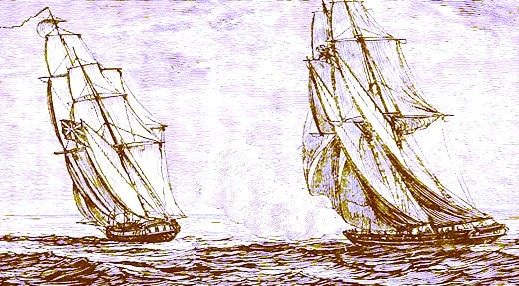
The Pirate Desoto Chasing the Morning Star, From The Sea, Vol. II, 1887
Days contending with contrary Winds and Currents, found themselves thirty Leagues to Leeward. The Current still opposing their Endeavours, and perceiving no Hopes of beating up to their Ship, they came to an Anchor, and inconsiderately sent away the Boat to give the rest of the Company Notice of their Condition, and to order the Ship to them; but too soon, even the next Day, their Wants made them sensible of their Infatuation, for their Water was all expended, and they had taken no thought how they should be supply'd, till either the Ship came, or the Boat returned, which was not likely to be under five or six Days." (Captain Charles Johnson, A General History of the Pyrates, 2nd Ed., 1724, p. 223-4)
Fresh water is crucial to survival. It rates just behind air and shelter in the hierarchy of needs for maintaining human life.
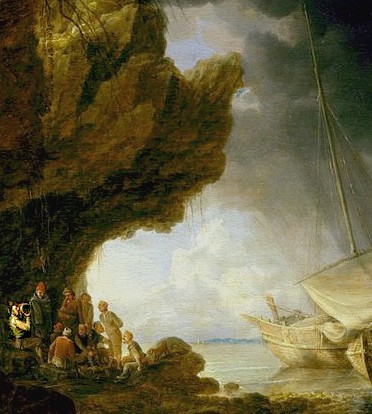
Artist: Bonaventure Peeters
Sailors Sheltering From the Rain, One Drinking From Keg, (1640s)
In broad terms the human body must maintain water balance - what is taken in via food and drink must be balanced by what is lost through urination, excretion, sweating and breathing. Sweating and breathing are particularly affected by what a person is doing and environmental factors such as the temperature. As a result, in a challenging or taxing situation, a person may only survive a few hours without water; under more sedate, comfortable conditions, they may survive a week or a little more.1
Men on ships at sea during the golden age of piracy were acutely aware of their need for water. Dutchess Captain Edward Cooke recorded that during Woodes Rogers' privateering voyage he "caus’d two of my Men to be whipp’d and pickled for stealing Water, and other Offences" in 1709.2
How much water was needed depended on the number of men on the ship, the length of the voyage and the amount of time between stops. One contemporary observer estimated that on a "Voyage to be made to Surrat... one Butt of Water [126 gallons], for Drink alone, is the ordinary Allowance for one man"3. It is roughly 6600 miles from Britain to Surat, India by sea.4 Using 5 knots (1.151 mph) as the average speed for a sailing vessel in the 1700s5, the journey would have taken about 240 days. There are admittedly a number of factors that could affect this calculation, but accepting this conceit as being correct, a voyage would require about 1/2 gallon of water or four pints a day per man.
Since most of the fresh water for a ship's voyage during this period was gotten from land, what was needed was stored on the ship in large water casks. Ships sailing during the late 17th and early 18th centuries did not usually reserve space for large amounts of water. Charles Grey comments that while there were initially ships of 1000 tons they were found 'unsuitable' due to challenge of getting them loaded
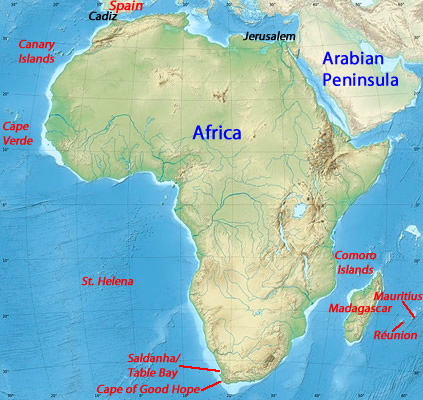
Map Created By: Eric Gaba
Water Locations on East Indies Sailing Route Around Africa in 17th/18th c.
before monsoon season and the problem of crewing such large ships. "Hence the tonnage during the seventeenth century rarely exceeded 600 tons, the usual ranging between 300 and 500, mostly about midway. Such small vessels being unable to carry full provisions and water for the whole voyage, several ports of call became necessary"6. Note that here 'tonnage' refers to the amount of cargo a ship could carry. The word comes from the number of 'tuns' - large casks which each contained about 252 gallons of wine - that a ship could hold.
As a result, nearly all detailed seventeenth and eighteenth century accounts of sea voyages from this period mention regular stops to procure fresh water and other provisions. The ship's route had to be planned so that the ship could stop and refill the water casks on long voyages. Two general travel routes that are featured in much of the sea literature from the golden age of piracy are commercial and exploratory voyages to the East and West Indies. Grey explains that ships traveling to the East Indies "would call at the Canaries, the Cape Verde Islands, St. Helena, Table Bay (then called Saldanha) and after rounding the Cape [of Good Hope], at some place on the Madagascar coast or the Islands."7 The 'Islands' refers to those close to Madagascar such as Mauritius, Réunion or one of the Comoro Islands.
Most of the trade routes to the West Indies during this period followed a very rough triangular pattern. (Note that the map below shows the curvature of the globe, so a triangle, one corner of which is already distorted by travel along the North American coast, looks even more distorted.) The slave trade went from Europe, down to the western coast of Africa to get slaves and then across the Atlantic to the Caribbean or Southern part of North America.
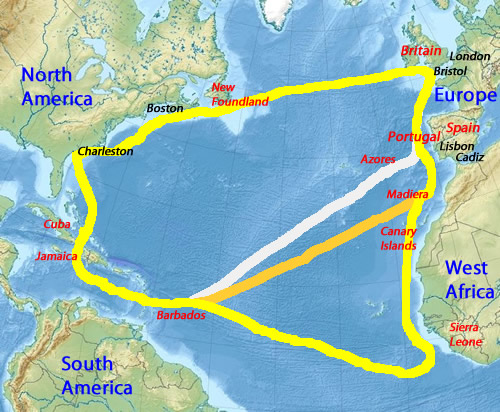
North Atlantic Places of Interest to Trade
The sugar and tobacco traders followed a similar route, going down from Europe to either to the Azores or Madeira and then across to the new world. The sugar traders would head for Barbados or Jamaica while the tobacco traders went to Barbados or Charleston, South Carolina. Merchant and trade vessels would then travel up the North American coast to Boston or Newfoundland and cross the ocean back to Europe.8 This route was one of necessity, dictated by the major Atlantic currents.
The longest part of this voyage was that across the Atlantic. Ian Steele says that an eight-and-one-half-week crossing was average for a merchantman going from Madeira to Barbados during the late fall.9 This was where having an adequate water supply became particularly important since there were no places to stop for fresh water during that two month voyage.
Because of this long passage, a ship's casks would be filled with fresh water before setting out to cross the ocean and then would be refilled when they reached their destination. The need for water was so great, a variety of methods were used to try and obtain it while at sea during this period. These will be discussed in the first part of this article. When conditions worked against them and the ship was unable to make timely landfall, water was rationed to the detriment of the crew. While the lack of fresh water was one of the most serious problems encountered at sea, it was not the only one fresh water caused sailors. The various problems associated with getting, maintaining and keeping fresh water at sea will be examined in the second part of this article. Finally, since water impacted health and health care, the article will finish with a look at how fresh water and health were intertwined.
1 Randall K. Packer, "How long can the average person survive without water?", Scientific American webpage, gathered 5/6/17; 2 Edward Cooke, A Voyage to the South Sea and Round the World in the Years 1708 to 1711, 1969, p. 301; 3 Nemiah Grew, New experiments and useful observations concerning seawater made fresh according to the Patentee’s invention, 1683, p. 31; 4 Based on Calculation of Travel From the UK to Surat, Searates.com website, gathered 5/15/17; 5 "How fast did ships travel in the 1700s?", reference.com, gathered 5/15/17; 6,7 Charles Grey, Pirates of the Eastern Seas (1618-1723), 1933, p. 50; 8 See Ian K. Steele, The English Atlantic 1275/1740, 1986. Chapters 1-3 (pp. 3-56); 9 Steele, p. 3
Casks
Before exploring the ways water was procured, we must first look at the tool used to gather and keep it: the cask. "A cask is a term to describe any piece of cooperage containing a bouge, bilge, or bulge produced in the middle of a container."1 Casks were a popular storage medium for many materials during this period and they were the primary method for storing water. Different sized casks were made from wooden staves and then bound with iron hoops. 'Tight' or 'wet' casks were designed to either keep liquid from getting in or out (depending on what was stored inside) while dry barrels were less rigorously constructed and used only to store dry goods. The wet casks required to store water would have been made from oak staves cut from trees averaging three feet in diameter and the staves themselves were at least an inch thick.2
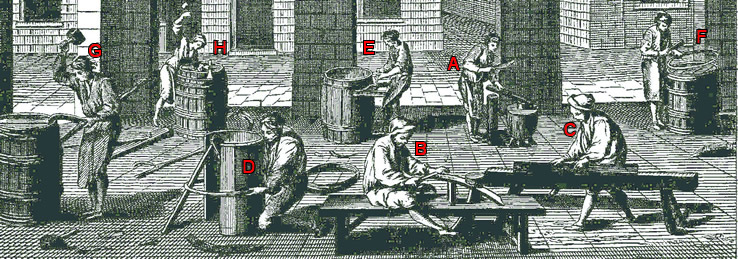 Coopers Making Casks from Denis Diderot's Encyclopédie, Vol. 10, Plate 1 (1751) A - Preparing a stave using a cooper's curved axe; B - Shaving a stave on the shaving-horse; C - Planing a stave over the jointer; D - Mounting a barrel; E - Tightening the barrel with a windlass; F - Notching the hoop; G - Placing the cross-bar with a cant-hook; H - Driving the hoops with a driver or drift |
Knives were then used to shape the angle of the stave and give the cask its bulge. "This has always been the hardest part of the profession because it takes a a careful eye and attention to detail to precisely see the proper radii of the cask."3 These staves were then tightly fitted together to prevent leakage. Some of the details of the manufacturing process for casks can be seen in the image above. For a detailed description of how casks were made with numerous illustrations, see Raymond Townsend's paper on the Colonial Williamsburg website.
The building of casks was more of an art than a science. Townsend explains that coopers "work
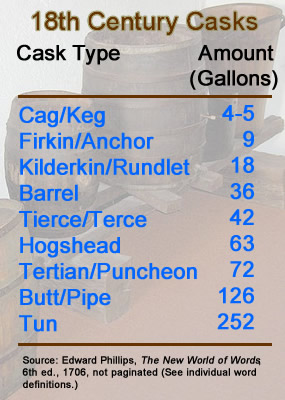
Background Photo: Georges Jansoone
to no written measurements or patterns, and to make a barrel of a specified diameter and capacity they depend on long experience and instinct alone."4 As he indicates, casks were built in a variety of sizes according to what they were used for. The chart at left shows the approximate standard sizes of casks from this period.
Several of these types of casks can be found mentioned in period descriptions of life at sea. Cags/Kegs are found there holding water5 and cheap wine (rack)6. Firkins were used to transport butter on naval vessels7. 'Half-barrels' (called 'kilderkins/rundlets' in the chart) were found containing flour, and sugar, rum and tobacco.8 Barrels were used to transport a wide variety of substances including herring9, water10, flour11, sugar12, beef13, biscuit/bread14, pork15, rice16, wine17and molasses18. These were clearly one of the cask workhorses of the period. Hogsheads are mentioned in conjunction with water19, pork20, wine21, rum22, molassas23, seal oil24, beer25, brandy26 and cider or ale27. A puncheon is only mentioned as containing rice.28 Butts are found in sea documents containing beer29, water30, and wine31 with pipes nearly always mentioned as being filled with wine32. Tuns are found in period manuscripts filled with water33, oil34, brandy35 and beer36.
There are a couple of things worth noting here. First, the above list of what each type
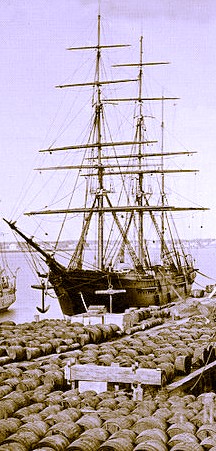
Barrels at the Port of Philadelphia with
the Elizabeth, From The Petroleum Age
Vol 2 No. 4 (1861)
of cask is said to contain is hardly exhaustive. This list is only meant to show the variety of things that were stored in different types of casks. A rigorous reading of these and other contemporary accounts would almost certainly turn up other uses for casks.
Second, the term 'barrel' can have a more generic meaning, so care should be taken when noting the amount mentioned as being in barrels. In addition, not every container necessarily contains the exact measure specified. For example, Ephraim Chambers' Cyclopedia explains that an 'English barrel' is a wine measure, the description of which matches this chart. However, he also notes that when referring to a barrel of beer, "it contains thirty-six gallons; and of ale thirty-two gallons.... The [regular, not English] barrel of beer, vinegar, or liquor [liquid] preparing for vinegar, is to contain 34 gallons, according to the standard of an ale quart."37 He gives a second definition for barrel which "contains 32 gallons, wine measure... usually amounting to about 1000 full herrings. The barrel of salmon [is] to contain 42 gallons... And the barrel of eels, the same."38
Third, similar to the problem of the word 'barrel', 'tun' is also used to describe the weight of items. It is not always clear in the period texts whether the author is talking about the container tun of a substance, or a ton in weight.
Another point of interest, Edward Phillips' 1706 dictionary also mentions what each cask measure is in fractions of other containers. While this is rather self-referential, it does help clarify the way the cask sizes came about. In Phillips' book, a kilderkin is defined as being two firkins, a firkin is a quarter of a barrel, a barrel two kilderkins, a butt contains two hogsheads, a hogshead a fourth of a tun, a tun is two pipes, a pipe is a half a tun and a tertian (or puncheon) is a third of a tun.39
Nor are the casks in the chart not the only sizes used. During a stop to get water in 1705 from a difficult location, William Funnell said that "each Man had filled his six Gallon Cask" which he then took to fill a canvas pipe that had been placed on a hillside to convey water to larger casks at the bottom of the hill.40 While William Dampier's was in Australia getting water, he mentions that they gathered water "in small long Barrels, about 6 Gallons in each, which were made purposely to carry Water in"41. Another size of cask was brought to brought to captain George Roberts by a group of locals on São Nicolau. "They came on Board to the Number of seven; all lusty stout young Fellows, and brought with them two ten Gallon Casks full of Water, and bid me drink heartily of it."42 These smaller casks were likely created for ease of 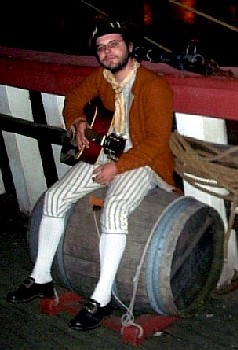
Reenactor Nathanael Logsdon Sitting on
The Santa Maria Replica Ship's Water Cask
carrying water between the source and the larger tuns. Since many ships had coopers, a variety of other sizes could have been custom built. Several texts mention bringing casks onto land to fill them with water in passing43, although most do not give any detail about the cask size.
Of course casks weren't the only vessels used to hold water. Just about any empty container could be used, particularly when transporting it from the shore to the ship. On a stop to refresh Woodes Rogers' fleet of privateering vessels in 1709, Dutchess captain Edward Cooke explained that they "moor’d our Ships, got up our empty Jars, and sent all our Boats for Water, and to know whether the Indians would trade with us."44 Fellow privateer George Shelvocke mentioned that in April 1721 while on Isla del Cano off Costa Rica the crew spotted water, but the surf there made it too dangerous to bring casks ashore. So some of his men made the trip taking "some jars to try what could be done… they came on board with their jars filled. …but as they did not bring off above 60 or 70 gallons"45. Dampier says that after being stranded in the Nicobar Islands, he prepared for a canoe trip, by bringing "12 large Coco-nut shells, that had all the Kernel taken out, yet were preserved whole except only a small hole at one end ; and all these held for us about 3 gallons and a half of Water. We bought also 2 or 3 Bamboes, that held about 4 or 5 Gallons more: This was our Sea-store."46
Of more interest as far as alternative containers were concerned was Shelvocke's construction of a water container on his ship so that he could sail from the Western Coast of Central America across the Pacific Ocean. While near Panama, Shelvocke's crew "built a tank, or wooden
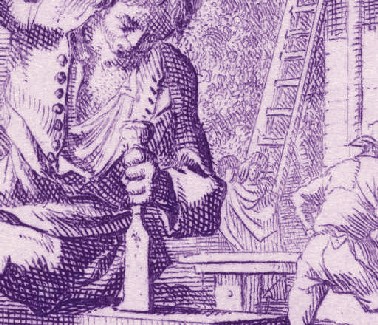
Artist: Jan Luyken - A Carpenter at Work (1694)
cistern, big enough to hold ten tons of water, instead of cask, without the assistance of which we could have but little hopes of being able to depart from these coasts"47. However, Shelvocke claimed "some of those who opposed our departure, did so much damage clandestinely to our tank, that the greatest part of the water in it leak'd out"48. He did not give up on the tank, however, testing it several months later, because "it contain’d the greatest part of our water, our lives depended upon the firmness of that."49 It is not clear whether they were able to make the tank waterproof enough to be used. Shelvocke does mention that they ran out of water on their journey to Guam, which may or may not have had anything to do with the tank.
One account specifies how and where the water cask used by the men to get water was placed. In describing the treatment of the men on the ship Adventure, Chief Mate Abraham Parrott specified that "when they drank Water, there was a Cask with a Scuttle or Hole cut at the Bung [a stopper placed in a hole in the cask] enough to put a Cup in and drink when they pleas'd, lash'd fast to the Main-mast upon the Main-deck, fill'd as often as there was occasion."50
1 Bryan Wright, "The Cooper: Colonial Maker of Barrels and Casks", Colonial Sense Website, gathered 5/8/17; 2 Raymond R. Townsend, "Coopers", Colonial Williamsburg Digital Library, gathered 5/8/17; 3 Wright, gathered 5/8/17; 4 Townsend, gathered 5/9/17; 5 Captain Charles Johnson, A general history of the pirates, 2nd Edition, 1724, p. 342 & George Roberts, The Four Years Voyages of George Roberts, 1726, p. 117; 6 “Mutiny on the Ship Adventure”, Pirates in Their Own Words, 2014, Ed Fox, ed., p. 254; 7 Edward Barlow, Barlow’s Journal of his Life at Sea in King’s Ships, East and West Indiamen & Other Merchantman From 1659 to 1703, p. 493; 8 George Francis Dow and John Henry Edmonds, The Pirates of the New England Coast 1630-1730, 1996, p. 60; 9 Barlow, p. 255 & 266; 10 Barlow, p. 142, William Dampier, Memoirs of a Buccaneer, Dampier’s New Voyage Round the World -1697-, 1968, p. 65 & Keevil, p. 114; 11 Johnson, A general history, p. 70 & “William Phillips The Voluntary Confession and Discovery of William Phillips, 8 August, 1696. SP 63/358, ff. 127-132”, Pirates in Their Own Words, Ed Fox, ed., 2014, p. 25; 12 Johnson, General History, p. 361; 13 William Dampier, A Supplement of the Voyage Round the World, 1700, p. 38 & “William Phillips The Voluntary Confession and Discovery of William Phillips, 8 August, 1696. SP 63/358, ff. 127-132”, Pirates in Their Own Words, Ed Fox, ed., 2014, p. 23 & Dampier, Memoirs, 1968, p. 44; 14 Pere Jean-Baptiste Labat, The Memoirs of Pére Labat 1693-1705, 1970, p. 197 & Johnson, General History, p. 95; 15 Johnson, General History, p. 94 & 95 & Dow and Edmonds, p. 63, & 137, “David Herriot and Ignatius Pell on Blackbeard and Stede Bonnet, from The Tryals of Major Stede Bonnet, and other Pirates (London, 1719), pp. 44-48”, Pirates in Their Own Words, Ed Fox, ed., 2014, p. 99, 101 & 106 & Dampier, Memoirs, 1968, p. 44; 16 Johnson, General History, p. 94 & “David Herriot and Ignatius Pell on Blackbeard and Stede Bonnet, from The Tryals of Major Stede Bonnet, and other Pirates (London, 1719), pp. 44-48”, Pirates in Their Own Words, Ed Fox, ed., 2014, pp. 101 & 106; 17 Dampier, Memoirs, 1968, p. 362-3; 18 The Tryals of Major Stede Bonnet, 1719, p. 12 & 15; 19 Nathaniel Boteler, Boteler's Dialogues, 1929, p. 292, Johnson, General History, p. 241 & John Keevil, Medicine and Navy, Vol. 1, 1957, p. 103; 20 Boteler, p. 56; 21 Johnson, General History, p. 353, , Nathaniel Uring, A history of the voyages and travels of Capt. Nathaniel Uring, 1928, p. 241 & Dampier, Memoirs, 1968, p. 44 & 70; 22 Johnson, General History, p. 95 & 361, "The Tryals of Major Stede Bonnet...”, Pirates in Their Own Words, p. 100, “30. Alexander Thompson, "The Information of Alexander Thompson 2 May, 1722. HCA 1/55 ff. 23-24”, Pirates in Their Own Words, Ed Fox, ed., 2014, p. 142, & Jeremy Roch, from Bruce S. Ingram, Three Sea Journals of Stuart Times, 1936, p. 127; 23 "The Tryals of Major Stede Bonnet, and other Pirates (London, 1719), pp. 44-48”, Pirates in Their Own Words, Ed Fox, ed., 2014, p. 100, 101 & 106, & Johnson, General History, p. 94; 24 Dampier, Memoirs, 1968, p. 70; 25 Boteler, p. 57-8 & “William Phillips ...”, Pirates in Their Own Words, p. 29; 26 Johnson, General History, p. 103 & Dampier, Memoirs, 1968, p. 70; 27 Uring, p. 241; 28 Dampier, Memoirs, 1968, p. 70; 29 Keevil, Volume II , p. 173; “27. 30 "Richard Luntly, from The Last Speech and Dying Words of Richard Luntly (Edinburgh, 1721”, Pirates in Their Own Words, Ed Fox, ed., 2014, p. 123, Woodes Rogers, A Cruising Voyage Round the World, 2004, p. 20; & Barlow, p. 54; 31 Barlow, p. 53; 32 Barlow, p. 53, Uring, p. 223, “28. The petition of John Massey and George Lowther, from EXT 1/261, ff. 197-199", Pirates in Their Own Words, Ed Fox, ed., 2014, p. 133, Captain Charles Johnson, The History of the Pirates, 1829, p. 103 & “28. The petition of John Massey and George Lowther, from EXT 1/261, ff. 197-199", Pirates in Their Own Words, Ed Fox, ed., 2014, p. 133; 33 William Funnell, A Voyage Round the World, 1969, p. 220, Alexander Hamilton, British sea-captain Alexander Hamilton's A new account of the
East Indies, 17th-18th century, 2002, p. 487; 34 Funnell, p. 22; 35 The Boston News-Letter, Monday August 15 to Monday August 22. 1720; 36 Boteler, p. 58; 37,38 Ephraim Chambers, Cyclopaedia, Or an Universal Dictionary of Arts and Sciences, Vol. 1, 1741, not paginated; 39 See Edward Phillips, The New World of Words,
6th ed., 1706, not paginated (Refer to individual word definitions.); 40 Funnell, p. 220; 41 William Dampier, A New Voyage Round the World, 1699, p. 468; 42 George Roberts, The Four Years Voyages of George Roberts, 1726, p. 121; 43 See for example, Philip Ashton, Ashton's Memorial, 1726, p. 40, Johnson, History of the Pirates, p. 108, 164 & 196, "56. Richard Lazenby, a prisoner of John Taylor, from The Narrative of Richard Lazenby", Pirates in Their Own Words, 2014, Ed Fox, ed., p. 280, Rogers, p. 25 & 272, Funnell, p. 220, Cooke, p. 20, Philip Alexander Bruce, Institutional History of Virginia In the Seventeenth Century, Volume II, 1910, p. 212, Barlow, p. 142 & 348 and Silas Told, An Account of the Life, and Dealings of God with Silas Told &c., 1786, p. 15; 44 Edward Cooke, A Voyage to the South Sea and Round the World in the Years 1708 to 1711, 1969, p. 299; 45 George Shelvocke, A Voyage Round the World by Way of the Great South Sea, 1726, p. 352; 46 Dampier, 1699, p. 490; 46 Shelvocke, p. 292; 46 Shelvocke, p. 294; 46 Shelvocke, p. 384; 50 “Mutiny on the Ship Adventure”, Pirates in Their Own Words, 2014, Ed Fox, ed., p. 254 p. 254
Water Casks and Coopers
Where there were casks, there were often coopers, even on ships. Coopers built, maintained and

Coopers Repairing Casks, From Naaukeurige versameling der gedenk-waardigste
zee en land-reysen na Oost en West-Indiën, Vol. 12, p. 40 (1708)
repaired the barrels on board ships. Future Massachusetts Bay Colony governor John Alden "was hired at the last minute as cooper of the Mayflower. His job was to repair damage to the water casks on board."1
The presence of a cooper on ships is either implied or directly referred to by several authors from this era. While aboard the East Indiaman Experiment in 1670, Edward Barlow states that they put ashore "our casks for water; and making a a tent there, our cooper fitted them on shore"2. Chaplain Henry Teonge mentions the cooper's role a couple of times in his diary of the time spent in service of the Royal Navy in the late 17th century. During a stop at Zakynthos, Greece in September of 1675, he noted that "all our time is spent in preparing our cask for freshwater, and for beverage-wine."3 A month later, while at Cape Porcus, near Alexandretta, Teonge mentioned that an "Empty cask [was] carried on shore to be mended and sweetened."4 'Sweetening' and 'preparing' a cask involved making it ready for liquids that were to be consumed by the men.
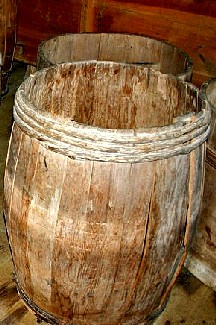
Photo Ernst Velkne
Casks with Vine-Like Hoops
Woodes Rogers provides an interesting detail about coopers on his voyage three year voyage around the world. "I borrow’d a Cooper from the Dutchess [his consort ship], and having five of my own, made quick dispatch."5 This means there were at least six coopers on this voyage, and likely more than that since the number of coopers on the Dutchess was not specified.
Upon reaching Santa Caterina Island off São José, Brazil, fellow privateer George Shelvocke "order'd the Cooper, and his crew to trim the casks, and fill water."6 Like Rogers, Shelvocke had a team of coopers aboard, highlighting their importance to such long voyages.
Even pirates had coopers in their service. During his time spent among Edward Low's pirates, captive Philip Ashton mentioned that on "Saturday the 9th of March, 1723, the Cooper with Six hands in the Long-Boat were going ashore at the Watering place to fill their Casks"7. This may at first seem like an unusual task for a skilled man, but if a problem occurred with the cask, he would be no hand to repair it, saving time in collecting water. This might be important given how long filling the casks could take. (This will be discussed in more detail in the section Problems With Fresh Water at Sea - Procurement.)
Pirate ships not only had coopers, they had good ones. Nathaniel North's crew was preparing to go to sea "but on examining their water casks, they found the hoops all

Artist: William Darton - Cooper, From Little Jack of All Trades (1814)
worm eaten and rotten, so that there was no proceeding; but this defect was repaired by their cooper, who was an ingenious fellow."8 The cooper gathered tough, flexible branches and "fitted them [the casks] up, and made them tight; in acknowledgment of which service they chose him captain, and North was made quarter-master."9 In this unusual situation, a man was made captain of a pirate ship because of his skill as a cooper! It is also notable that this passage suggests that the pirates were ready to abandon their voyage because they had no casks.
Of course, like every job, being the cooper had its challenges. Slaver Thomas Phillips noted that when they were visiting St. Thomas, an armed guard was "constantly oblig'd to watch the cask in the night, else the Portuguese, who are the greatest thieves in the world, would steal all their iron hoops off."10 That was a minor inconvenience compared to what happened to Captain Kidd's cooper. While attempting to get water during a cruise along the coast of India, Kidd stopped on one of the Laccadive Islands off the western coast of India to obtain water and other provisions. Here, after they abused the local native population "in the usual disorderly manner, the natives, in revenge, cut off and murdered the cooper whilst he was ashore having the water casks filled"7. By way of revenge, Kidd reportedly tied the murderer to a tree and shot him.
1 Bryan Wright, "The Cooper: Colonial Maker of Barrels and Casks", Colonial Sense Website, gathered 5/8/17; 2 Edward Barlow, Barlow’s Journal of his Life at Sea in King’s Ships, East and West Indiamen & Other Merchantman From 1659 to 1703, p. 184; 3 Henry Teonge, The Diary of Henry Teonge, Chaplain on Board H.M.’s Ships Assistance, Bristol, and Royal Oak, 1675-1679, 1927, p. 75; 4 Teonge, p. 91; 5 Woodes Rogers, A Cruising Voyage Round the World, 1712, p. 25; 6 George Shelvocke, A Voyage Round the World by Way of the Great South Sea, 1726, p. 18; 7 Philip Ashton, Ashton's Memorial, 1726, p. 40; 8,9 Captain Charles Johnson, The History of the Pirates, 1829, p. 191; 10 Thomas Phillips, 'A Journal of a Voyage Made in the Hannibal', A Collection of Voyages and Travels, Vol. VI, Awnsham Churchill. ed., p.232; 11 Charles Grey, Pirates of the Eastern Seas (1618-1723), 1971, p. 202

